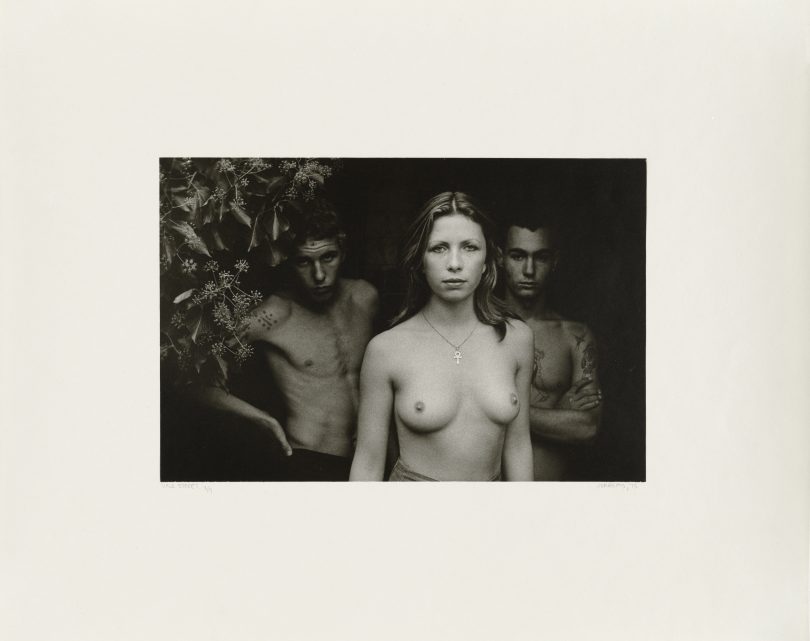
Seven Sisters, by Tjungkara Ken, Sandra Ken, Yaritji Young, Freda Brady and Maringka Tunkin. Photo: National Gallery of Australia.
“I walked through the first room of Aboriginal women artists and the further I went, the more I felt my emotions welling up,” says Savanhndary Vongpoothorn. “It was such a true celebration and so powerful.”
Savanhndary is a Canberra-based, major contemporary Australian artist. She’s among the women whose work is hung in Know My Name, the National Gallery of Australia’s (NGA) new exhibition. And she’s not alone in finding the exhibition a powerful experience.
Know My Name has mushroomed into an event taking place around Australia, including a cultural partnership with the ANU’s Kambri precinct where Here I Am! – an exhibition of contemporary emerging women artists – was launched last week.
The Know My Name exhibition – delivered in two parts – showcases more than 400 works by around 170 artists during the course of a year, encouraging audiences to consider and celebrate women’s role in the history of Australian art.
One of its drivers was research indicating only 25 per cent of the NGA’s Australian art collection was by women.
Natasha Bullock, the National Gallery of Australia’s assistant director, artistic programs, says the exhibition is a very public demonstration of a deeper commitment throughout the institution.
“We know there are more names to know, and more work to do, but this is the start of the structural change we need to achieve gender equity in the gallery and in our sector,” she says.

Installation details from the Know My Name exhibition. Photo: National Gallery of Australia.
In response, NGA curators Deborah Hart and Elspeth Pitt proposed an exhibition of women’s artworks from 1900 to the present time, and they say the lightbulb moment for NGA director Nick Mitzevich was a simple question: who would know their names?
The reverberations of the Me Too movement also pulse through the show’s DNA – the idea that history doesn’t have a single heroic narrative, but takes many forms.
It’s a notion that reverberates with Savanhndary, whose early career work, Various Layers, hangs in the show. The work speaks of her experience as a woman with Lao heritage, a deep reverence for her textile-heavy culture, a strong matrilineal heritage, and the experience of growing up in multicultural Australia.

Canberra artist Savanhndary Vongpoothorn. Photo: File.
“Art is where you can have that safe space to follow your passions,” she says. “Art is a safe space to explore cultures that are not familiar to you, and ideas you need to work through.”
Deborah says that from the outset, the curators wanted to honour Aboriginal women artists. Following those powerful works led to art that was about the environment, collaboration and relationships. There was a conscious focus on practices that have been excluded or sidelined because they were categorised as ‘women’s art’.
The resulting connections are often unexpected, says Elspeth, referencing the likes of Janet Cumbrae-Stewart, a gay woman working in Paris in the 1930s.
“Her subjects are charged with eroticism and that, in turn, led us to photographers from the 1980s who were deconstructing ideas about the male gaze,” says Elspeth. “Know My Name gives us the chance to examine complex relationships and put those ideas up against each other.”

Installation of the Tjanpi Weavers work at the National Gallery of Australia. Photo: National Gallery of Australia.
Women also made a dynamic contribution to modernism and abstraction in Australia, but often remain hidden. Deborah points to Margaret Worth’s art as an example. Married to the much better known sculptor Syd Ball, she worked with mid-century titans Sol LeWitt and Richard Serra.
Deborah says Worth’s daughter was exultant when she learned her mother’s work would finally receive the recognition it had always deserved on a national scale.
For Elspeth, the exhibition feels like a beginning rather than an end point. She notes that in the past, many exhibitions included a token woman.
“There were always arguments over whether the work was ‘good enough’,” she says. “We’ve shown it’s always been good enough, from First Nations and Federation onwards.”
Savanhndary claims the title of woman artist proudly, as a descriptor of something different rather than lesser.

Vale Street by Carol Jerrams, 1975. Photo: National Gallery of Australia.
Currently, she’s working on a series using found materials collected on lockdown walks with her family up Mount Ainslie. Casuarina seeds and banksia fronds are forming mandalas that reference her cultural origins and the textile patterns from her Lao family, and she’s looking at the scribbly gum patterns made by moth larvae.
Asked if she calls herself a woman artist, she says yes, definitively.
“I’m very comfortable with that,” says Savanhndary. “I love that; it’s who I am. I’m a mother, a wife and a woman artist. Those are all intrinsic parts of my identity.”
Know My Name: Australian Women Artists 1900 to Now is open at the National Gallery of Australia. Part one will be on display until 4 July, 2021. Part two opens in July 2021.
The exhibition is open from 10 am to 5 pm daily, excluding Christmas Day. Entry is free.





















